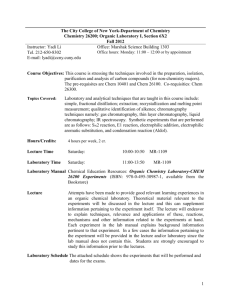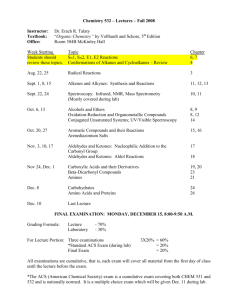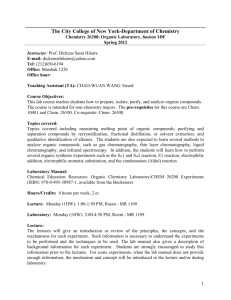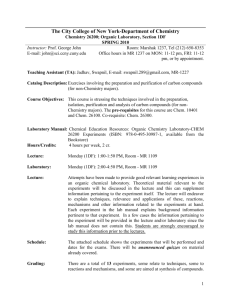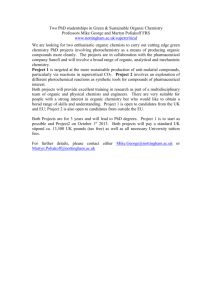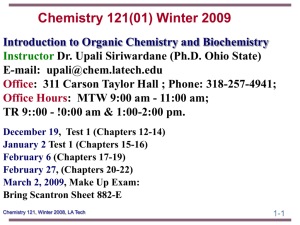Department of Chemistry - The City College of New York
advertisement
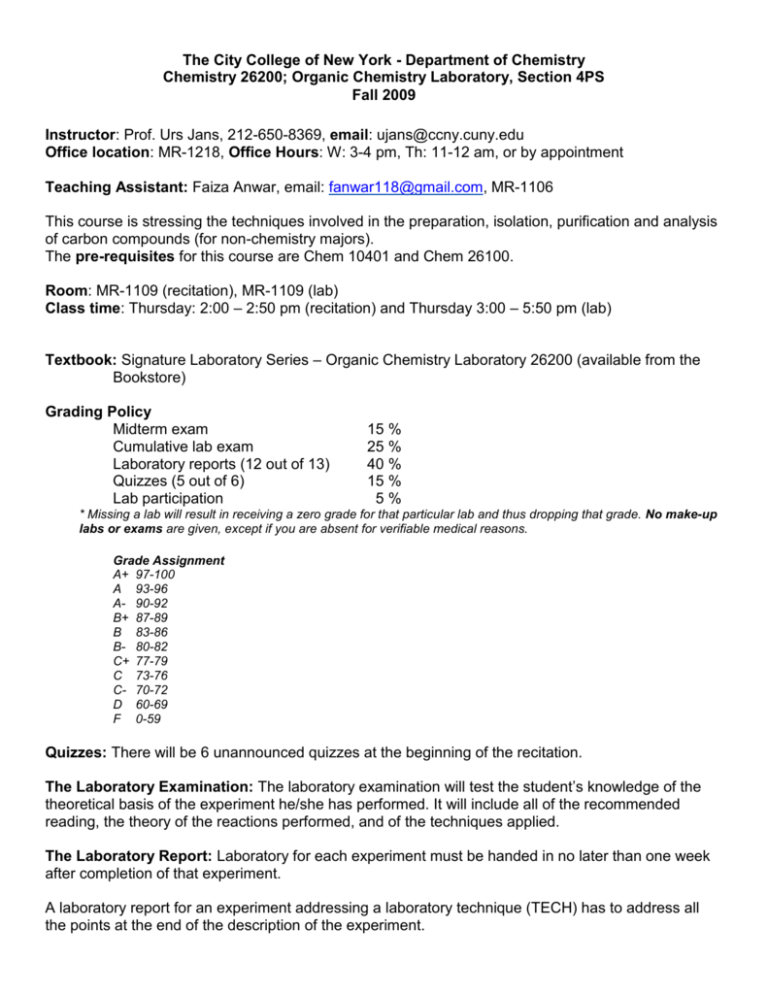
The City College of New York - Department of Chemistry Chemistry 26200; Organic Chemistry Laboratory, Section 4PS Fall 2009 Instructor: Prof. Urs Jans, 212-650-8369, email: ujans@ccny.cuny.edu Office location: MR-1218, Office Hours: W: 3-4 pm, Th: 11-12 am, or by appointment Teaching Assistant: Faiza Anwar, email: fanwar118@gmail.com, MR-1106 This course is stressing the techniques involved in the preparation, isolation, purification and analysis of carbon compounds (for non-chemistry majors). The pre-requisites for this course are Chem 10401 and Chem 26100. Room: MR-1109 (recitation), MR-1109 (lab) Class time: Thursday: 2:00 – 2:50 pm (recitation) and Thursday 3:00 – 5:50 pm (lab) Textbook: Signature Laboratory Series – Organic Chemistry Laboratory 26200 (available from the Bookstore) Grading Policy Midterm exam Cumulative lab exam Laboratory reports (12 out of 13) Quizzes (5 out of 6) Lab participation 15 % 25 % 40 % 15 % 5% * Missing a lab will result in receiving a zero grade for that particular lab and thus dropping that grade. No make-up labs or exams are given, except if you are absent for verifiable medical reasons. Grade Assignment A+ 97-100 A 93-96 A- 90-92 B+ 87-89 B 83-86 B- 80-82 C+ 77-79 C 73-76 C- 70-72 D 60-69 F 0-59 Quizzes: There will be 6 unannounced quizzes at the beginning of the recitation. The Laboratory Examination: The laboratory examination will test the student’s knowledge of the theoretical basis of the experiment he/she has performed. It will include all of the recommended reading, the theory of the reactions performed, and of the techniques applied. The Laboratory Report: Laboratory for each experiment must be handed in no later than one week after completion of that experiment. A laboratory report for an experiment addressing a laboratory technique (TECH) has to address all the points at the end of the description of the experiment. You must prepare your laboratory reports for the synthesis experiments (REAC or SYNT) in accordance with the following outline. 1 2 3 4 5 6 7 8 9 Name, ID number and section Title of experiment Aim of experiment Any equations chemical structures relevant to the experiment as well as any pertinent mechanisms. A table listing the compounds used, their molecular weights, amounts used in grams and moles, boiling points and density (for liquids), as applicable Hazards: determine flammability, toxicity or corrosiveness of the compounds used in this experiment Procedure and Observations: Describe exactly how you performed the experiment and exactly what observations were made (e.g., color change, if any spillage occurred etc.). The observations have to be very specific. Draw a separation scheme or a flowchart. Always write this part in the third person and in past tense. Results: This part should include identification of the limiting reagent and calculation of the theoretical yield of the product. Actual yield of the product, physical properties of the compounds such as color or nature of product (e.g., colorless needles of compound X were obtained). Melting or boiling points. Conclusions: Did you achieve what had to be achieved? Did you have any problems, if so discuss these. Other scientific comments on the experiments, such as suggestions if you feel you could do something differently to improve the outcome of the experiment. 5 5 10 10 10 10 20 20 10 Information about reagent and chemicals can be obtained from a number of sources. The most common resources are the CRC Handbook of Chemistry and Physics, the Material Safety Data Sheet or the Aldrich Catalog. There are also a number of sources for this information online. A page listing theses sources has been assembled by the campus science librarian at the url: http://resources.ccny.cuny.edu/resources/subject.jsp?sub_id=62#273 Sections 1 to 6 are the components of the preliminary laboratory report. This part helps the student to prepare for the proper performance of the relevant laboratory preparations and ensures the instructor that all of the required reading has been done. Sections 1 to 6 have to be prepared at home, during the week preceding the first laboratory session for the new experiment. The preliminary laboratory report has to be ready at the beginning of the lecture of the laboratory session for that experiment. Section 7, 8 and 9 must be completed in the laboratory. The sample lab report (hand out) might also give you some insight in how the different sections are structured. The completed laboratory report is handed in on the last day assigned for the particular experiment. Handing in the lab report after this deadline results in a deduction of 20 points from the mark of this lab report. Schedule: The schedule shows the experiments that will be performed and when the exams will be held. The chapters, which describe techniques especially relevant to each experiment are listed in italics adjacent to the experiment numbers. You are strongly advised to read these chapters in the textbook. Since some techniques will be used more than once in the laboratory course, the examination questions on techniques will be chosen based only on the relevance of the techniques to the particular laboratory experiment. Make-up Sessions, Absences: No make-up exams, or laboratory sessions, can be arranged. It is the student’s responsibility to ensure that he/she can attend all the laboratory sessions, on time. An absence from a laboratory without a suitable strong excuse will result in a mark of zero being assigned. Cumulative Laboratory Exam: A cumulative laboratory exam (90 min) will be given at the end of the course (Dec. 10) and accounts for 25% to the final mark of the course. The cumulative laboratory exam will focus on the techniques and not on the reaction mechanisms. Safety: All of the safety regulations must be adhered to. (Safety goggles will be worn at all times. Sandals are not allowed in the lab). Any willful violation of our safety rules will result in the student’s immediate expulsion from the laboratory and a course grade of F. Breakages: Students must be aware of the fact that they will be charged the replacement cost of any equipment, which they break during the lab course. Some of our glassware is especially expensive and so you are urged to work carefully at all times. Academic Integrity: The CCNY policy on academic integrity will be followed. A document is posted on the CCNY website (CUNY policy on academic integrity: www1.ccny.cuny.edu/facultystaff/provost/upload/academicintegrity.pdf-2007-01-19). Make sure you have read the details regarding plagiarism and cheating, in case you are not clear about the rules of the college. Cases where academic integrity is compromised will be prosecuted according to these rules. Course Learning Outcomes for Chem 26200: 1. To understand the physical principles underlying the techniques used for purification of compounds, separation of reaction mixtures, monitoring reactions and analyzing reaction products in organic chemistry lab. 2. Understand the mechanistic basis of synthetic experiments. 3. To learn and execute several fundamental organic laboratory techniques used. 4. To perform fundamental organic reactions. 5. To learn the safety precautions required in an organic lab. 6. To learn the calculations associated with synthetic organic experiments. 7. To learn how to make observations, collect data and write a lab report for an organic synthesis experiment. City College of New York – Chemistry Department Chemistry 26200 – Organic Chemistry Laboratory – Fall 2009, Section 4PS Schedule of Experiments: Sept. 3 Introduction, Check In, Melting Points of Compounds and Mixtures TECH 701 Sept. 10 Purifying Acetanilide by Recrystallization TECH 703 Sept. 17 Separating Cyclohexane and Toluene by Distillation TECH 704 Sept. 24 Separating Acids and Neutral Compounds by Solvent Extraction TECH 705 Oct. 1 Separating Ferrocene and Acetylferrocene by Adsorption Column Chromatography TECH 708 Oct. 8 Gas Chromatography and Thin Layer Chromatography Oct. 15 Brominating Alkenes (Group 1); Identifying an Unknown Compound by Infrared Spectroscopy (Group 2) TECH 719 TECH 710 Oct. 22 Brominating Alkenes (Group 2); Identifying an Unknown Compound by Infrared Spectroscopy (Group 1) TECH 719 TECH 710 Oct. 29 Qualitative Test for Alkenes and Identifying an Unknown Compound by Infrared Spectroscopy TECH 472 Nov. 5 Studying SN1 and SN2 Reactions: Nucleophilic Substitution at Saturated Carbon REAC 714 Nov. 12 Dehydrating Cyclohexanol REAC 712 Nov. 19 Nitrating Methyl Benzoate REAC 716 Dec. 3 The Aldol Condensation: Synthesis of Dibenzylacetone SYNT 720 Dec. 10 Equipment Check Out
